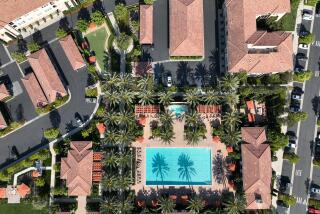CLIPBOARD
- Share via
Although North Tustin goes by the name of its closest neighbor, it’s actually not part of the city of Tustin at all. It remains an unincorporated portion of county territory sandwiched between Tustin, Orange and the older, established neighborhoods of Cowan Heights and Lemon Heights.
The area is patrolled by the county sheriff’s department, but other services such as water are received from the city of Tustin. North Tustin children attend schools in the Tustin school districts.
Earlier this year, attempts to annex portions of the area to Tustin were countered by residents who wanted to incorporate into a completely new city. Proponents of incorporation stressed the issue of local control, even though cityhood would mean higher taxes, since the area has almost no sales tax revenues.
However, some residents preferred annexation to Tustin and argued that forming a new city would not be financially viable and would reduce the quality of services. Others, such as long-term residents Ted and Maureen Rischard, favor the present arrangement. “If it works well, why change it?” asked Mrs. Rischard, who was born in Orange County and moved to North Tustin in 1947.
Public hearings on the issue were scheduled for June, but were postponed until a report from the state controller’s office is completed and reviewed by the Local Agency Formation Commission, which reviews local government plans for annexation or incorporation.
The neighborhood’s identity crisis is also illustrated by the small pockets of farmland tucked among neighborhoods developed long ago. Both contrast with newer developments, complete with look-alike exteriors, gated entrances and CC&Rs.;
In spite of its state of flux, the neighborhood remains popular with upper-middle-class home buyers who, according to Kris Kapp, sales manager at the new Belle River housing development, like the area’s quiet, semi-rural atmosphere and proximity to major North County employers. “A lot of doctors and other health care professionals have purchased homes here because we’re close to hospitals like UCI Medical Center and CHOC,” Kapp said.
According to Kapp, one of the first things prospective buyers inquire about is the quality of the local schools. “That’s typical of upper-income professionals. Education is a priority for them and strongly influences their decisions,” said Kapp.
The neighborhood includes Foothill High School, which has eight National Merit Scholars in this year’s senior class of 300. “That’s quite a few,” said Foothill counselor John Amdon. “We had seven last year and 13 in 1989.”
Amdon credits local parental participation for the strong academic showing. “Professional people expect their kids to go on to college and at least 55% of our students attend four-year colleges as freshmen,” said Amdon. “Another 35% go on to community colleges.”
Amdon considers the school’s career center one of the most important features on campus. “That’s the place where students go to put what they are doing now into a future perspective. We have visits from recruiters and representatives from various professions come by to talk and it helps them see the road up ahead,” he explained.
Foothill art instructor Elizabeth Gecsey has converted the school’s hallways, lunch rooms and conference rooms into gallery spaces for her students. “Part of being an artist is showing your work. It’s not good to produce something creative and hide it under the bed,” Gecsey said.
“When you teach art, you become accustomed to improvising, and the hallways seemed like a perfect place to start a gallery,” she said.
For now, the neighborhood carrys on much the same as it always has. But the state controller’s report is due in just a few months and hearings on the annexation or incorporation issue will resume. Once again the neighborhood will buzz with rumors and residents will pack the hearing rooms to decide their future.
Population Total: (1990) 3,898 1980-90 change: -2.4% Median Age: 37.1
Racial/ethnic mix: White (non-Latino): 87% Latino: 6% Black: Less than 1% Other: 6%
By sex and age: MALES Median age: 34.2 years FEMALES Median age: 40.3 years
Income Per capita: $26,170 Median household: $67,009 Average household: $79,468
Income Distribution: Less than $25,000: 10% $25,000-49,999: 19% $50,000-74,999: 31% $75,000-$99,999: 18% $100,000 and more: 22%
More to Read
Sign up for Essential California
The most important California stories and recommendations in your inbox every morning.
You may occasionally receive promotional content from the Los Angeles Times.












